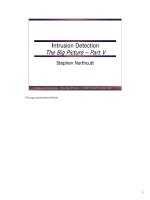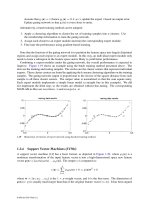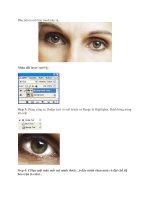Tài liệu Solution of Linear Algebraic Equations part 10 docx
Bạn đang xem bản rút gọn của tài liệu. Xem và tải ngay bản đầy đủ của tài liệu tại đây (211.56 KB, 10 trang )
2.7 Sparse Linear Systems
89
Sample page from NUMERICAL RECIPES IN C: THE ART OF SCIENTIFIC COMPUTING (ISBN 0-521-43108-5)
Copyright (C) 1988-1992 by Cambridge University Press.Programs Copyright (C) 1988-1992 by Numerical Recipes Software.
Permission is granted for internet users to make one paper copy for their own personal use. Further reproduction, or any copying of machine-
readable files (including this one) to any servercomputer, is strictly prohibited. To order Numerical Recipes books,diskettes, or CDROMs
visit website or call 1-800-872-7423 (North America only),or send email to (outside North America).
void dsprstx(double sa[], unsigned long ija[], double x[], double b[],
unsigned long n);
These are double versions of sprsax and sprstx.
if (itrnsp) dsprstx(sa,ija,x,r,n);
else dsprsax(sa,ija,x,r,n);
}
extern unsigned long ija[];
extern double sa[]; The matrix is stored somewhere.
void asolve(unsigned long n, double b[], double x[], int itrnsp)
{
unsigned long i;
for(i=1;i<=n;i++) x[i]=(sa[i] != 0.0 ? b[i]/sa[i] : b[i]);
The matrix
A is the diagonal part of A,storedinthefirstnelements of sa.Sincethe
transpose matrix has the same diagonal, the flag itrnsp is not used.
}
CITED REFERENCES AND FURTHER READING:
Tewarson, R.P. 1973,
Sparse Matrices
(New York: Academic Press). [1]
Jacobs, D.A.H. (ed.) 1977,
The State of the Art in Numerical Analysis
(London: Academic
Press), Chapter I.3 (by J.K. Reid). [2]
George, A., and Liu, J.W.H. 1981,
Computer Solution of Large Sparse Positive Definite Systems
(Englewood Cliffs, NJ: Prentice-Hall). [3]
NAG Fortran Library
(Numerical Algorithms Group, 256 Banbury Road, Oxford OX27DE, U.K.).
[4]
IMSL Math/Library Users Manual
(IMSL Inc., 2500 CityWest Boulevard, Houston TX 77042). [5]
Eisenstat, S.C., Gursky, M.C., Schultz, M.H., and Sherman, A.H. 1977,
Yale Sparse Matrix Pack-
age
, Technical Reports 112 and 114 (Yale University Department of Computer Science). [6]
Knuth, D.E. 1968,
Fundamental Algorithms
, vol. 1 of
The Art of Computer Programming
(Reading,
MA: Addison-Wesley),
§2.2.6. [7]
Kincaid, D.R., Respess, J.R., Young, D.M., and Grimes, R.G. 1982,
ACM Transactions on Math-
ematical Software
, vol. 8, pp. 302–322. [8]
PCGPAK User’s Guide
(New Haven: Scientific Computing Associates, Inc.). [9]
Bentley, J. 1986,
Programming Pearls
(Reading, MA: Addison-Wesley), §9. [10]
Golub, G.H., and Van Loan, C.F. 1989,
Matrix Computations
, 2nd ed. (Baltimore: Johns Hopkins
University Press), Chapters 4 and 10, particularly
§§10.2–10.3. [11]
Stoer, J., and Bulirsch, R. 1980,
Introduction to Numerical Analysis
(New York: Springer-Verlag),
Chapter 8. [12]
Baker, L. 1991,
More C Tools for Scientists and Engineers
(New York: McGraw-Hill). [13]
Fletcher, R. 1976, in
Numerical Analysis Dundee 1975
, Lecture Notes in Mathematics, vol. 506,
A. Dold and B Eckmann, eds. (Berlin: Springer-Verlag), pp. 73–89. [14]
Saad, Y., and Schulz, M. 1986,
SIAM Journal on Scientific and Statistical Computing
,vol.7,
pp. 856–869. [15]
Bunch, J.R., and Rose, D.J. (eds.) 1976,
Sparse Matrix Computations
(New York: Academic
Press).
Duff, I.S., and Stewart, G.W. (eds.) 1979,
Sparse Matrix Proceedings 1978
(Philadelphia:
S.I.A.M.).
90
Chapter 2. Solution of Linear Algebraic Equations
Sample page from NUMERICAL RECIPES IN C: THE ART OF SCIENTIFIC COMPUTING (ISBN 0-521-43108-5)
Copyright (C) 1988-1992 by Cambridge University Press.Programs Copyright (C) 1988-1992 by Numerical Recipes Software.
Permission is granted for internet users to make one paper copy for their own personal use. Further reproduction, or any copying of machine-
readable files (including this one) to any servercomputer, is strictly prohibited. To order Numerical Recipes books,diskettes, or CDROMs
visit website or call 1-800-872-7423 (North America only),or send email to (outside North America).
2.8 Vandermonde Matrices and Toeplitz
Matrices
In §2.4 the case of a tridiagonal matrix was treated specially, because that
particular type of linear system admits a solution in only of order N operations,
rather than of order N
3
for the general linear problem. When such particular types
exist, it is important to know about them. Your computational savings, should you
ever happen to be working on a problem that involves the right kind of particular
type, can be enormous.
This section treats two special types of matrices that can be solved in of order
N
2
operations, not as good as tridiagonal, but a lot better than the general case.
(Other than the operations count, these two types having nothing in common.)
Matrices of the first type, termed Vandermonde matrices, occur in some problems
having to do with the fitting of polynomials, the reconstruction of distributionsfrom
their moments, and also other contexts. In this book, for example, a Vandermonde
problem crops up in §3.5. Matrices of the second type, termed Toeplitz matrices,
tend to occur in problems involving deconvolution and signal processing. In this
book, a Toeplitz problem is encountered in §13.7.
These are not the only special types of matrices worth knowing about. The
Hilbert matrices, whose components are of the form a
ij
=1/(i+j−1),i,j=
1, ,N can be inverted by an exact integer algorithm, and are very difficult to
invert in any other way, since they are notoriouslyill-conditioned(see
[1]
for details).
The Sherman-Morrison and Woodbury formulas, discussed in §2.7, can sometimes
be used to convert new special forms into old ones. Reference
[2]
gives some other
special forms. We have not found these additional forms to arise as frequently as
the two that we now discuss.
Vandermonde Matrices
A Vandermonde matrix of size N × N is completely determined by N arbitrary
numbers x
1
,x
2
, ,x
N
, in terms of which its N
2
components are the integer powers
x
j−1
i
,i,j=1, ,N. Evidently there are two possible such forms, depending on whether
we view the i’s as rows, j ’s as columns, or vice versa. In the former case, we get a linear
system of equations that looks like this,
1 x
1
x
2
1
··· x
N−1
1
1 x
2
x
2
2
··· x
N−1
2
.
.
.
.
.
.
.
.
.
.
.
.
1 x
N
x
2
N
··· x
N−1
N
·
c
1
c
2
.
.
.
c
N
=
y
1
y
2
.
.
.
y
N
(2.8.1)
Performing the matrix multiplication, you will see that this equation solves for the unknown
coefficients c
i
which fit a polynomial to the N pairs of abscissas and ordinates (x
j
,y
j
).
Precisely this problem will arise in §3.5, and the routine given there will solve (2.8.1) by the
method that we are about to describe.
2.8 Vandermonde Matrices and Toeplitz Matrices
91
Sample page from NUMERICAL RECIPES IN C: THE ART OF SCIENTIFIC COMPUTING (ISBN 0-521-43108-5)
Copyright (C) 1988-1992 by Cambridge University Press.Programs Copyright (C) 1988-1992 by Numerical Recipes Software.
Permission is granted for internet users to make one paper copy for their own personal use. Further reproduction, or any copying of machine-
readable files (including this one) to any servercomputer, is strictly prohibited. To order Numerical Recipes books,diskettes, or CDROMs
visit website or call 1-800-872-7423 (North America only),or send email to (outside North America).
The alternative identification of rows and columns leads to the set of equations
11··· 1
x
1
x
2
··· x
N
x
2
1
x
2
2
··· x
2
N
···
x
N−1
1
x
N−1
2
··· x
N−1
N
·
w
1
w
2
w
3
···
w
N
=
q
1
q
2
q
3
···
q
N
(2.8.2)
Write this out and you will see that it relates to the problem of moments: Given the values
of N points x
i
, find the unknown weights w
i
, assigned so as to match the given values
q
j
of the first N moments. (For more on this problem, consult
[3]
.) The routine given in
this section solves (2.8.2).
The method of solution of both (2.8.1) and (2.8.2) is closely related to Lagrange’s
polynomialinterpolation formula, which we will notformally meetuntil§3.1 below. Notwith-
standing, the following derivation should be comprehensible:
Let P
j
(x) be the polynomial of degree N − 1 defined by
P
j
(x)=
N
n=1
(n=j)
x − x
n
x
j
− x
n
=
N
k=1
A
jk
x
k−1
(2.8.3)
Here the meaning of the last equality is to define the components of the matrix A
ij
as the
coefficients that arise when the product is multiplied out and like terms collected.
The polynomial P
j
(x) is a function of x generally. But you will notice that it is
specifically designed so that it takes on a value of zero at all x
i
with i = j, and has a value
of unity at x = x
j
.Inotherwords,
P
j
(x
i
)=δ
ij
=
N
k=1
A
jk
x
k−1
i
(2.8.4)
But (2.8.4) says that A
jk
is exactly the inverse of the matrix of componentsx
k−1
i
,which
appears in (2.8.2), with the subscript as the column index. Therefore the solution of (2.8.2)
is just that matrix inverse times the right-hand side,
w
j
=
N
k=1
A
jk
q
k
(2.8.5)
As for the transpose problem (2.8.1), we can use the fact that the inverse of the transpose
is the transpose of the inverse, so
c
j
=
N
k=1
A
kj
y
k
(2.8.6)
The routine in §3.5 implements this.
It remains to find a good way of multiplying out the monomial terms in (2.8.3), in order
to get the components of A
jk
. This is essentially a bookkeepingproblem, and we will let you
read the routine itself to see how it can be solved. One trick is to define a master P (x) by
P (x) ≡
N
n=1
(x − x
n
)(2.8.7)
work out its coefficients, and then obtain the numerators and denominators of the specific
P
j
’s via synthetic division by the one supernumerary term. (See §5.3 for more on synthetic
division.) Since each such division is only a process of order N, the total procedure is
of order N
2
.
You should be warned that Vandermonde systems are notoriously ill-conditioned, by
their very nature. (As an aside anticipating §5.8, the reason is the same as that which makes
Chebyshev fitting so impressively accurate: there exist high-order polynomials that are very
good uniform fits to zero. Hence roundoff error can introduce rather substantial coefficients
of the leading terms of these polynomials.) It is a goodidea always to compute Vandermonde
problems in double precision.
92
Chapter 2. Solution of Linear Algebraic Equations
Sample page from NUMERICAL RECIPES IN C: THE ART OF SCIENTIFIC COMPUTING (ISBN 0-521-43108-5)
Copyright (C) 1988-1992 by Cambridge University Press.Programs Copyright (C) 1988-1992 by Numerical Recipes Software.
Permission is granted for internet users to make one paper copy for their own personal use. Further reproduction, or any copying of machine-
readable files (including this one) to any servercomputer, is strictly prohibited. To order Numerical Recipes books,diskettes, or CDROMs
visit website or call 1-800-872-7423 (North America only),or send email to (outside North America).
The routine for (2.8.2) which follows is due to G.B. Rybicki.
#include "nrutil.h"
void vander(double x[], double w[], double q[], int n)
Solves the Vandermonde linear system
N
i=1
x
k− 1
i
w
i
= q
k
(k =1, ,N). Input consists of
the vectors
x[1 n] and q[1 n]; the vector w[1 n] is output.
{
int i,j,k;
double b,s,t,xx;
double *c;
c=dvector(1,n);
if (n == 1) w[1]=q[1];
else {
for (i=1;i<=n;i++) c[i]=0.0; Initialize array.
c[n] = -x[1]; Coefficients of the master polynomial are found
by recursion.for (i=2;i<=n;i++) {
xx = -x[i];
for (j=(n+1-i);j<=(n-1);j++) c[j] += xx*c[j+1];
c[n] += xx;
}
for (i=1;i<=n;i++) { Each subfactor in turn
xx=x[i];
t=b=1.0;
s=q[n];
for (k=n;k>=2;k ) { is synthetically divided,
b=c[k]+xx*b;
s += q[k-1]*b; matrix-multiplied by the right-hand side,
t=xx*t+b;
}
w[i]=s/t; and supplied with a denominator.
}
}
free_dvector(c,1,n);
}
Toeplitz Matrices
An N × N Toeplitz matrix is specified by giving 2N − 1 numbers R
k
,k=−N+
1, ,−1,0,1, ,N −1. Those numbers are then emplaced as matrix elements constant
along the (upper-left to lower-right) diagonals of the matrix:
R
0
R
−1
R
−2
··· R
−(N−2)
R
−(N −1)
R
1
R
0
R
−1
··· R
−(N−3)
R
−(N −2)
R
2
R
1
R
0
··· R
−(N−4)
R
−(N −3)
··· ···
R
N−2
R
N−3
R
N−4
··· R
0
R
−1
R
N−1
R
N−2
R
N−3
··· R
1
R
0
(2.8.8)
The linear Toeplitz problem can thus be written as
N
j=1
R
i−j
x
j
= y
i
(i =1, ,N)(2.8.9)
where the x
j
’s, j =1, ,N, are the unknowns to be solved for.
The Toeplitz matrix is symmetric if R
k
= R
−k
for all k.Levinson
[4]
developed an
algorithm for fast solution of the symmetric Toeplitz problem, by a bordering method,thatis,
2.8 Vandermonde Matrices and Toeplitz Matrices
93
Sample page from NUMERICAL RECIPES IN C: THE ART OF SCIENTIFIC COMPUTING (ISBN 0-521-43108-5)
Copyright (C) 1988-1992 by Cambridge University Press.Programs Copyright (C) 1988-1992 by Numerical Recipes Software.
Permission is granted for internet users to make one paper copy for their own personal use. Further reproduction, or any copying of machine-
readable files (including this one) to any servercomputer, is strictly prohibited. To order Numerical Recipes books,diskettes, or CDROMs
visit website or call 1-800-872-7423 (North America only),or send email to (outside North America).
a recursive procedure that solves the M-dimensional Toeplitz problem
M
j=1
R
i−j
x
(M )
j
= y
i
(i =1, ,M)(2.8.10)
in turn for M =1,2, until M = N, the desired result, is finally reached. The vector x
(M)
j
is the result at the M th stage, and becomes the desired answer only when N is reached.
Levinson’s method is well documented in standard texts (e.g.,
[5]
). The useful fact that
the method generalizes to the nonsymmetric case seems to be less well known. At some risk
of excessive detail, we therefore give a derivation here, due to G.B. Rybicki.
In following a recursion from step M to step M +1we findthat our developing solution
x
(M)
changes in this way:
M
j=1
R
i−j
x
(M )
j
= y
i
i =1, ,M (2.8.11)
becomes
M
j=1
R
i−j
x
(M +1)
j
+ R
i−(M +1)
x
(M +1)
M +1
= y
i
i =1, ,M +1 (2.8.12)
By eliminating y
i
we find
M
j=1
R
i−j
x
(M )
j
− x
(M +1)
j
x
(M +1)
M +1
= R
i−(M +1)
i =1, ,M (2.8.13)
or by letting i → M +1−iand j → M +1−j,
M
j=1
R
j−i
G
(M )
j
= R
−i
(2.8.14)
where
G
(M)
j
≡
x
(M)
M+1−j
− x
(M +1)
M +1−j
x
(M +1)
M +1
(2.8.15)
To put this another way,
x
(M+1)
M +1−j
= x
(M )
M +1−j
− x
(M +1)
M +1
G
(M )
j
j =1, ,M (2.8.16)
Thus, if we can use recursion to find the order M quantities x
(M )
and G
(M)
and the single
order M +1quantity x
(M +1)
M +1
, then all of the other x
(M +1)
j
will follow. Fortunately, the
quantity x
(M +1)
M +1
follows from equation (2.8.12) with i = M +1,
M
j=1
R
M +1−j
x
(M +1)
j
+ R
0
x
(M +1)
M +1
= y
M +1
(2.8.17)
For the unknown order M +1 quantities x
(M +1)
j
we can substitute the previous order
quantities in G since
G
(M)
M+1−j
=
x
(M )
j
− x
(M +1)
j
x
(M +1)
M +1
(2.8.18)
The result of this operation is
x
(M+1)
M +1
=
M
j=1
R
M +1−j
x
(M )
j
− y
M +1
M
j=1
R
M +1−j
G
(M )
M +1−j
− R
0
(2.8.19)
94
Chapter 2. Solution of Linear Algebraic Equations
Sample page from NUMERICAL RECIPES IN C: THE ART OF SCIENTIFIC COMPUTING (ISBN 0-521-43108-5)
Copyright (C) 1988-1992 by Cambridge University Press.Programs Copyright (C) 1988-1992 by Numerical Recipes Software.
Permission is granted for internet users to make one paper copy for their own personal use. Further reproduction, or any copying of machine-
readable files (including this one) to any servercomputer, is strictly prohibited. To order Numerical Recipes books,diskettes, or CDROMs
visit website or call 1-800-872-7423 (North America only),or send email to (outside North America).
The only remaining problem is to develop a recursion relation for G. Beforewedo
that, however, we should point out that there are actually two distinct sets of solutions to the
original linear problem for a nonsymmetric matrix, namely right-hand solutions (which we
have been discussing) and left-hand solutions z
i
. The formalism for the left-hand solutions
differs only in that we deal with the equations
M
j=1
R
j−i
z
(M )
j
= y
i
i =1, ,M (2.8.20)
Then, the same sequence of operations on this set leads to
M
j=1
R
i−j
H
(M )
j
= R
i
(2.8.21)
where
H
(M)
j
≡
z
(M)
M+1−j
− z
(M +1)
M +1−j
z
(M +1)
M +1
(2.8.22)
(compare with 2.8.14 – 2.8.15). The reason for mentioning the left-hand solutions now is
that, by equation (2.8.21), the H
j
satisfy exactly the same equation as the x
j
except for
the substitution y
i
→ R
i
on the right-hand side. Therefore we can quickly deduce from
equation (2.8.19) that
H
(M+1)
M +1
=
M
j=1
R
M +1−j
H
(M )
j
− R
M +1
M
j=1
R
M +1−j
G
(M )
M +1−j
− R
0
(2.8.23)
By the same token, G satisfies the same equation as z, except for the substitution y
i
→ R
−i
.
This gives
G
(M+1)
M +1
=
M
j=1
R
j−M −1
G
(M )
j
− R
−M −1
M
j=1
R
j−M −1
H
(M )
M +1−j
− R
0
(2.8.24)
The same“morphism” also turns equation(2.8.16), andits partnerforz, into thefinal equations
G
(M+1)
j
= G
(M )
j
− G
(M +1)
M +1
H
(M )
M +1−j
H
(M +1)
j
= H
(M )
j
− H
(M +1)
M +1
G
(M )
M +1−j
(2.8.25)
Now, starting with the initial values
x
(1)
1
= y
1
/R
0
G
(1)
1
= R
−1
/R
0
H
(1)
1
= R
1
/R
0
(2.8.26)
we can recurse away. At each stage M we use equations (2.8.23) and (2.8.24) to find
H
(M+1)
M +1
,G
(M+1)
M +1
, and thenequation (2.8.25)tofindtheothercomponents ofH
(M+1)
,G
(M+1)
.
From there the vectors x
(M+1)
and/or z
(M+1)
are easily calculated.
The program belowdoes this. It incorporates the second equation in (2.8.25) in the form
H
(M+1)
M +1−j
= H
(M )
M +1−j
− H
(M +1)
M +1
G
(M )
j
(2.8.27)
so that the computation can be done “in place.”
Notice that the above algorithm fails if R
0
=0. In fact, because the bordering method
does not allow pivoting, the algorithm will fail if any of the diagonal principal minors of the
original Toeplitz matrix vanish. (Compare with discussion of the tridiagonal algorithm in
§2.4.) If the algorithm fails, your matrix is not necessarily singular — you might just have
to solve your problem by a slower and more general algorithm such as LU decomposition
with pivoting.
The routine that implements equations (2.8.23)–(2.8.27) is also due to Rybicki. Note
that the routine’s r[n+j] is equal to R
j
above, so that subscripts on the r array vary from
1 to 2N − 1.
2.8 Vandermonde Matrices and Toeplitz Matrices
95
Sample page from NUMERICAL RECIPES IN C: THE ART OF SCIENTIFIC COMPUTING (ISBN 0-521-43108-5)
Copyright (C) 1988-1992 by Cambridge University Press.Programs Copyright (C) 1988-1992 by Numerical Recipes Software.
Permission is granted for internet users to make one paper copy for their own personal use. Further reproduction, or any copying of machine-
readable files (including this one) to any servercomputer, is strictly prohibited. To order Numerical Recipes books,diskettes, or CDROMs
visit website or call 1-800-872-7423 (North America only),or send email to (outside North America).
#include "nrutil.h"
#define FREERETURN {free_vector(h,1,n);free_vector(g,1,n);return;}
void toeplz(float r[], float x[], float y[], int n)
Solves the Toeplitz system
N
j=1
R
(N +i−j)
x
j
= y
i
(i =1, ,N). The Toeplitz matrix need
not be symmetric.
y[1 n] and r[1 2*n-1] are input arrays; x[1 n] is the output array.
{
int j,k,m,m1,m2;
float pp,pt1,pt2,qq,qt1,qt2,sd,sgd,sgn,shn,sxn;
float *g,*h;
if (r[n] == 0.0) nrerror("toeplz-1 singular principal minor");
g=vector(1,n);
h=vector(1,n);
x[1]=y[1]/r[n]; Initialize for the recursion.
if (n == 1) FREERETURN
g[1]=r[n-1]/r[n];
h[1]=r[n+1]/r[n];
for (m=1;m<=n;m++) { Main loop over the recursion.
m1=m+1;
sxn = -y[m1]; Compute numerator and denominator for x,
sd = -r[n];
for (j=1;j<=m;j++) {
sxn += r[n+m1-j]*x[j];
sd += r[n+m1-j]*g[m-j+1];
}
if (sd == 0.0) nrerror("toeplz-2 singular principal minor");
x[m1]=sxn/sd; whence x.
for (j=1;j<=m;j++) x[j] -= x[m1]*g[m-j+1];
if (m1 == n) FREERETURN
sgn = -r[n-m1]; Compute numerator and denominator for G and H,
shn = -r[n+m1];
sgd = -r[n];
for (j=1;j<=m;j++) {
sgn += r[n+j-m1]*g[j];
shn += r[n+m1-j]*h[j];
sgd += r[n+j-m1]*h[m-j+1];
}
if (sd == 0.0 || sgd == 0.0) nrerror("toeplz-3 singular principal minor");
g[m1]=sgn/sgd; whence G and H.
h[m1]=shn/sd;
k=m;
m2=(m+1) >> 1;
pp=g[m1];
qq=h[m1];
for (j=1;j<=m2;j++) {
pt1=g[j];
pt2=g[k];
qt1=h[j];
qt2=h[k];
g[j]=pt1-pp*qt2;
g[k]=pt2-pp*qt1;
h[j]=qt1-qq*pt2;
h[k ]=qt2-qq*pt1;
}
} Back for another recurrence.
nrerror("toeplz - should not arrive here!");
}
If you are in the businessof solvingverylarge Toeplitz systems,you shouldfind out about
so-called “new, fast” algorithms, which require only on the order of N(log N )
2
operations,
compared to N
2
for Levinson’s method. These methods are too complicated to include here.
96
Chapter 2. Solution of Linear Algebraic Equations
Sample page from NUMERICAL RECIPES IN C: THE ART OF SCIENTIFIC COMPUTING (ISBN 0-521-43108-5)
Copyright (C) 1988-1992 by Cambridge University Press.Programs Copyright (C) 1988-1992 by Numerical Recipes Software.
Permission is granted for internet users to make one paper copy for their own personal use. Further reproduction, or any copying of machine-
readable files (including this one) to any servercomputer, is strictly prohibited. To order Numerical Recipes books,diskettes, or CDROMs
visit website or call 1-800-872-7423 (North America only),or send email to (outside North America).
Papers by Bunch
[6]
and de Hoog
[7]
will give entry to the literature.
CITED REFERENCES AND FURTHER READING:
Golub, G.H., and Van Loan, C.F. 1989,
Matrix Computations
, 2nd ed. (Baltimore: Johns Hopkins
University Press), Chapter 5 [also treats some other special forms].
Forsythe, G.E., and Moler, C.B. 1967,
Computer Solution of Linear Algebraic Systems
(Engle-
wood Cliffs, NJ: Prentice-Hall),
§19. [1]
Westlake, J.R. 1968,
A Handbook of Numerical Matrix Inversion and Solution of Linear Equations
(New York: Wiley). [2]
von Mises, R. 1964,
Mathematical Theory of Probability and Statistics
(New York: Academic
Press), pp. 394ff. [3]
Levinson, N., Appendix B of N. Wiener, 1949,
Extrapolation, Interpolation and Smoothing of
Stationary Time Series
(New York: Wiley). [4]
Robinson, E.A., and Treitel, S. 1980,
Geophysical Signal Analysis
(Englewood Cliffs, NJ: Prentice-
Hall), pp. 163ff. [5]
Bunch, J.R. 1985,
SIAM Journal on Scientific and Statistical Computing
, vol. 6, pp. 349–364. [6]
de Hoog, F. 1987,
Linear Algebra and Its Applications
, vol. 88/89, pp. 123–138. [7]
2.9 Cholesky Decomposition
If a square matrix A happens to be symmetric and positive definite, then it has a
special, more efficient, triangular decomposition. Symmetric means that a
ij
= a
ji
for
i, j =1, ,N, while positive definite means that
v · A · v > 0 for all vectors v (2.9.1)
(In Chapter 11 we will see that positive definite has the equivalent interpretation that A has
all positive eigenvalues.) While symmetric, positive definite matrices are rather special, they
occur quite frequently in some applications, so their special factorization, called Cholesky
decomposition, is good to know about. When you can use it, Choleskydecomposition is about
a factor of two faster than alternative methods for solving linear equations.
Instead of seeking arbitrary lower and upper triangular factors L and U, Cholesky
decomposition constructs a lower triangular matrix L whose transpose L
T
can itself serve as
the upper triangular part. In other words we replace equation (2.3.1) by
L · L
T
= A (2.9.2)
This factorization is sometimes referred to as “taking the square root” of the matrix A.The
components of L
T
are of course related to those of L by
L
T
ij
= L
ji
(2.9.3)
Writing out equation (2.9.2) in components, one readily obtains the analogs of equations
(2.3.12)–(2.3.13),
L
ii
=
a
ii
−
i−1
k=1
L
2
ik
1/2
(2.9.4)
and
L
ji
=
1
L
ii
a
ij
−
i−1
k=1
L
ik
L
jk
j = i +1,i+2, ,N (2.9.5)
2.9 Cholesky Decomposition
97
Sample page from NUMERICAL RECIPES IN C: THE ART OF SCIENTIFIC COMPUTING (ISBN 0-521-43108-5)
Copyright (C) 1988-1992 by Cambridge University Press.Programs Copyright (C) 1988-1992 by Numerical Recipes Software.
Permission is granted for internet users to make one paper copy for their own personal use. Further reproduction, or any copying of machine-
readable files (including this one) to any servercomputer, is strictly prohibited. To order Numerical Recipes books,diskettes, or CDROMs
visit website or call 1-800-872-7423 (North America only),or send email to (outside North America).
If you apply equations (2.9.4) and (2.9.5) in the order i =1,2, ,N, you will see
that the L’s that occur on the right-hand side are already determined by the time they are
needed. Also, only components a
ij
with j ≥ i are referenced. (Since A is symmetric,
these have complete information.) It is convenient, then, to have the factor L overwrite the
subdiagonal (lower triangular but not including the diagonal) part of A, preserving the input
upper triangular values of A. Only one extra vector of length N is neededto store the diagonal
part of L. The operations count is N
3
/6 executions of the inner loop (consisting of one
multiply and one subtract), with also N square roots. As already mentioned, this is about a
factor 2 better than LU decomposition of A (where its symmetry would be ignored).
A straightforward implementation is
#include <math.h>
void choldc(float **a, int n, float p[])
Given a positive-definite symmetric matrix
a[1 n][1 n], this routine constructs its Cholesky
decomposition, A = L · L
T
. On input, only the upper triangle of a need be given; it is not
modified. The Cholesky factor L is returned in the lower triangle of
a, except for its diagonal
elements which are returned in
p[1 n].
{
void nrerror(char error_text[]);
int i,j,k;
float sum;
for (i=1;i<=n;i++) {
for (j=i;j<=n;j++) {
for (sum=a[i][j],k=i-1;k>=1;k ) sum -= a[i][k]*a[j][k];
if (i == j) {
if (sum <= 0.0) a, with rounding errors, is not positive definite.
nrerror("choldc failed");
p[i]=sqrt(sum);
} else a[j][i]=sum/p[i];
}
}
}
You might at this point wonder about pivoting. The pleasant answer is that Cholesky
decomposition is extremely stable numerically, without any pivoting at all. Failure of choldc
simply indicates that the matrix A (or, with roundoff error, another very nearby matrix) is
not positive definite. In fact, choldc is an efficient way to test whether a symmetric matrix
is positive definite. (In this application, you will want to replace the call to nrerror with
some less drastic signaling method.)
Once your matrix is decomposed, the triangular factor can be used to solve a linear
equation by backsubstitution. The straightforward implementation of this is
void cholsl(float **a, int n, float p[], float b[], float x[])
Solves the set of
n linear equations A · x = b,whereais a positive-definite symmetric matrix.
a[1 n][1 n] and p[1 n] are input as the output of the routine choldc. Only the lower
triangle of
a is accessed. b[1 n] is input as the right-hand side vector. The solution vector is
returned in
x[1 n]. a, n,andpare not modified and can be left in place for successive calls
with different right-hand sides
b. b is not modified unless you identify b and x in the calling
sequence, which is allowed.
{
int i,k;
float sum;
for (i=1;i<=n;i++) { Solve L · y = b,storingyin x.
for (sum=b[i],k=i-1;k>=1;k ) sum -= a[i][k]*x[k];
x[i]=sum/p[i];
}
for (i=n;i>=1;i ) { Solve L
T
· x = y.
for (sum=x[i],k=i+1;k<=n;k++) sum -= a[k][i]*x[k];
98
Chapter 2. Solution of Linear Algebraic Equations
Sample page from NUMERICAL RECIPES IN C: THE ART OF SCIENTIFIC COMPUTING (ISBN 0-521-43108-5)
Copyright (C) 1988-1992 by Cambridge University Press.Programs Copyright (C) 1988-1992 by Numerical Recipes Software.
Permission is granted for internet users to make one paper copy for their own personal use. Further reproduction, or any copying of machine-
readable files (including this one) to any servercomputer, is strictly prohibited. To order Numerical Recipes books,diskettes, or CDROMs
visit website or call 1-800-872-7423 (North America only),or send email to (outside North America).
x[i]=sum/p[i];
}
}
A typicaluse of choldc andcholslis in theinversionof covariancematrices describing
the fit of data to amodel; see, e.g., §15.6. In this, andmany other applications, one often needs
L
−1
. The lower triangle of this matrix can be efficiently found from the output of choldc:
for (i=1;i<=n;i++) {
a[i][i]=1.0/p[i];
for (j=i+1;j<=n;j++) {
sum=0.0;
for (k=i;k<j;k++) sum -= a[j][k]*a[k][i];
a[j][i]=sum/p[j];
}
}
CITED REFERENCES AND FURTHER READING:
Wilkinson, J.H., and Reinsch, C. 1971,
Linear Algebra
,vol.IIof
Handbook for Automatic Com-
putation
(New York: Springer-Verlag), Chapter I/1.
Gill, P.E., Murray, W., and Wright, M.H. 1991,
Numerical Linear Algebra and Optimization
,vol.1
(Redwood City, CA: Addison-Wesley),
§4.9.2.
Dahlquist, G., and Bjorck, A. 1974,
Numerical Methods
(Englewood Cliffs, NJ: Prentice-Hall),
§5.3.5.
Golub, G.H., and Van Loan, C.F. 1989,
Matrix Computations
, 2nd ed. (Baltimore: Johns Hopkins
University Press),
§4.2.
2.10 QR Decomposition
There is another matrix factorization that is sometimes very useful, the so-called QR
decomposition,
A = Q · R (2.10.1)
Here R is upper triangular, while Q is orthogonal, that is,
Q
T
· Q = 1 (2.10.2)
where Q
T
is the transpose matrix of Q. Although the decomposition exists for a general
rectangular matrix, we shall restrict our treatment to the casewhen all the matrices are square,
with dimensions N × N.
Like the other matrix factorizations we have met (LU, SVD, Cholesky), QR decompo-
sition can be used to solve systems of linear equations. To solve
A · x = b (2.10.3)
first form Q
T
· b and then solve
R · x = Q
T
· b (2.10.4)
by backsubstitution. Since QR decomposition involves about twice as many operations as
LU decomposition, it is not used for typical systems of linear equations. However, we will
meet special cases where QR is the method of choice.









